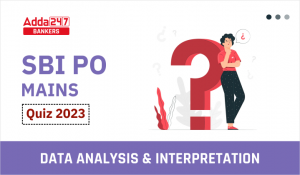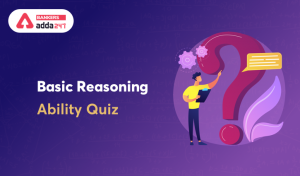Dear Aspirants,
Banking Awareness for Bank of India SO Exam 2018
With the increased competition in the field of banking examinations, it has now become very important to cover up all the sections efficiently. One subject that can help you bagging graceful marks in the minimum time in these examinations is Banking Awareness. Banking Awareness Quiz not only helps you deal with the General Awareness Section of Banking Exams but also, the Personal Interview round of Banking Recruitment.
Q1. As we all know, banks in India are required to maintain a portion of their demand and time liabilities with the Reserve Bank of India. This portion is called?
(a) statutory liquidity ratio
(b) cash reserve ratio
(c) bank deposit
(d) reverse repo
(e) government securities
S1. Ans.(b)
Sol. As we all know, banks in India are required to maintain a portion of their demand and time liabilities with the Reserve Bank of India. This portion is called Cash Reserve Ratio (CRR).
Q2. Reserve Bank of India is the lender of the last resort to scheduled commercial banks because-
(a) the parties can approach RBI when their limits are exhausted
(b) they are not able to get loans from other banks
(c) RBI can come to the rescue of a bank that is solvent but faces temporary liquidity problems by supplying it with much-needed liquidity when no one else is willing to extend credit to that bank
(d) All of the above
(e) None of the given options is true
S2. Ans.(c)
Sol. As a Banker to Banks, the Reserve Bank also acts as the ‘lender of the last resort’. It can come to the rescue of a bank that is solvent but faces temporary liquidity problems by supplying it with much-needed liquidity when no one else is willing to extend credit to that bank. The Reserve Bank extends this facility to protect the interest of the depositors of the bank and to prevent possible failure of the bank, which in turn may also affect other banks and institutions and can have an adverse impact on financial stability and thus on the economy.
Q3. Banks without the prior approval of the RBI, cannot-
(a) one a new place of business in India or abroad
(b) shift otherwise that within the same centers (city/town/village) of the existing place of business
(c) shift their sole rural branch outside the centre/village is not permitted, as such shifting would render the centre unbanded
(d) All of the above
(e) None of the given options is true
S3. Ans.(d)
Sol. All of the above.
Q4. The interest rate at which the RBI lends to commercial banks in the short term to maintain liquidity is known as-?
(a) interest rate
(b) repo rate
(c) reverse repo rate
(d) bank rate
(e) None of the given options is true
S4. Ans.(b)
Sol. The interest rate at which the RBI lends to commercial banks in the short term to maintain liquidity is known as repo rate.
Q5. Who is the final authority for deciding the design, form and material of bank notes?
(a) Central Government
(b) Reserve Bank of India
(c) Indian Banks Association
(d) Note Issuing Authority of India
(e) None of the given options is true
S5. Ans.(a)
Sol. Central Government is the final authority for deciding the design, form and material of bank notes.
Q6. The bank rate is-
(a) free to fluctuate according to the forces of demand and supply
(b) set by the RBI
(c) set by the RBI is directed by the Union Ministry of Finance
(d) set by the RBI as advised by the Indian Banks Association
(e) set by the Government of India on the recommendation of the Planning Commission
S6. Ans.(b)
Sol. The bank rate is set by the RBI.
Q7. As per the reports in various newspapers many private companies are trying to obtain the licences to launch a banking company in India. Which of the following organisations /agencies issue the licence for the same?
(a) Securities and Exchange Board of India (SEBI)
(b) Indian Institute of Banking and Finance (IIBF)
(c) Indian Banks’ Association
(d) Registrar of Companies
(e) None of the given options is true
S7. Ans.(e)
Sol. RBI is issue the licence for the the licences to launch a banking company in India.
Q8. Many times we read a term ‘Hot Money’ in newspapers. What is/are the characteristics of Hot Money?
I. The term is used for fresh currency notes issued by the RBI.
II. It is the fund which flows in the market to take advantage of high interest rates.
III. It is the fund which is thrown in the market to create imbalance in the stock markets.
Select the correct answer using the codes given below
(a) Only I
(b) Only II
(c) Only III
(d) All of the above
(e) None of the given options is true
S8. Ans.(b)
Sol. Hot Money is the fund which flows in the market to take advantage of high-interest rates.
Q9. What are the cooperative banks at the village level known as?
(a) Central cooperative banks
(b) Primary agricultural cooperative societies
(c) Village cooperative banks
(d) State cooperative banks
(e) None of the given options is true
S9. Ans.(b)
Sol. The rural co-operative credit system in India is primarily mandated to ensure flow of credit to the agriculture sector. It comprises short-term and long-term co-operative credit structures. The short-term co-operative credit structure operates with a three-tier system – Primary Agricultural Credit Societies (PACS) at the village level, Central Cooperative Banks (CCBs) at the district level and State Cooperative Banks (StCBs) at the State level. PACS are outside the purview of the Banking Regulation Act, 1949 and hence not regulated by the Reserve Bank of India. StCBs/DCCBs are registered under the provisions of State Cooperative Societies Act of the State concerned and are regulated by the Reserve Bank. Powers have been delegated to National Bank for Agricultural and Rural Development (NABARD) under Sec 35 A of the Banking Regulation Act (As Applicable to Cooperative Societies) to conduct inspection of State and Central Cooperative Banks.
Q10. Which of the following would result in a fall in asset prices?
(a) Low liquidity in the economy
(b) High liquidity in the economy
(c) RBI increasing the Reserve Repo Rates
(d) RBI allowing more banks to play
(e) None of the given options is true
S10. Ans.(a)
Sol. Low liquidity in the economy.
Q11. As per reports in the newspapers, the Indian Rupee is appreciating these days. What does it really mean?
I. The value of the Rupee has gone up. It is now 110 paise and not 100 paise.
II. The exchange rate of Rupee has gone up.
III. Now we can purchase more in one Rupee,
Which was not possible earlier?
(a) Only I
(b) Only II
(c) Only III
(d) Both I and II
(e) None of the given options is true
S11. Ans.(b)
Sol. The exchange rate of Rupee has gone up.
Q12. A customer wishes to purchase some US dollars in India. He/she should go to-
(a) Public Debt Division of the RBI only
(b) American Express Bank Only
(c) RBI or any branch of a Bank which is authorized for such business
(d) Ministry of Foreign Affairs
(e) None of the given options is true
S12. Ans.(c)
Sol. RBI or any branch of a Bank which is authorized for such business.
Q13. Consider the following-
I. Bank Rate Policy
II. Open Market Operations
III. Devaluation of Rupee
Which of the above are called fiscal measures?
(a) Only II
(b) Both I and II
(c) Both I and III
(d) Only III
(e) None of the given options is true
S13. Ans.(d)
Sol. Devaluation of Rupee.
Q14. The names of which of the following rates/ratios cannot be seen in financial newspapers?
(a) Bank Rate
(b) Repo Rate
(c) Statutory Liquidity Ratio
(d) Cash Reserve Ratio
(e) Pulse Rate
S14. Ans.(e)
Sol. Pulse rate is used in medical science.
Q15. Prior approval (as also a licence) of RBI is required for opening-
(a) personal banking branches
(b) merchant banking branches
(c) asset recovery branches
(d) All of the above
(e) None of the given options is true
S15. Ans.(d)
Sol. All of the above.






 Quantitative Aptitude Quiz For SBI PO Ma...
Quantitative Aptitude Quiz For SBI PO Ma...
 Inequalities Basic Reasoning Quiz for Al...
Inequalities Basic Reasoning Quiz for Al...




